I'll Get You One Day
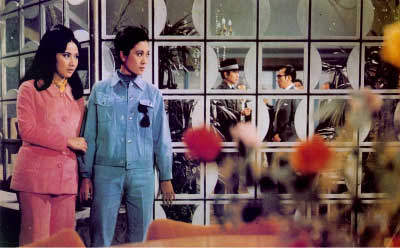
(Picture from "Silver Light" by Paul Fonoroff)
Director: Chan Lit-ban
Year: 1970
Rating: 7.5
Films shouldn’t be
this much fun. Even without subs this is an enormously enjoyable and entertaining
film as it switches back and forth between frothy go-go pop songs and frantic
kung fu female fighting. If this is a sample of the 1960’s Cantonese action
film scene I am in trouble because this stuff could become addictive. So
far very little of this market has been aimed at a Western audience in the
same way that the Shaw films have been recently and there has unfortunately
been minimum attempt to restore the aging prints. So the viewer has to put
up with more scratches than an alley cat and a general blanding of the color
palate, but at least for this film it is well worth putting up with these
minor distractions. This film was made in 1970 just as the Cantonese film
industry was hitting rock bottom with only 35 releases that year and 1 the
next until it began to rebound a few years later with the success of the
Hui Brothers.
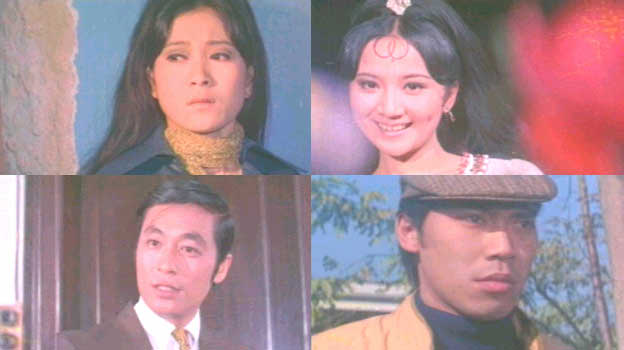
When it did though few of the stars of the earlier Cantonese film industry
came back with it unless it was more in supporting roles such as Woo Fung
and Kenneth Tsang or as a lead role in the occasional off-beat film like Josephine
Siao. Others simply moved over to television where they found success in
a medium that was still Cantonese based and some like Connie Chan Po-chu simply
retired with over 200 films under her belt at the age of 25. In fact, Connie
was to make only a few more films after this one – interestingly her final
film was her first one for the Shaw Brothers – “The Lizard” in 1972. One
might surmise that she didn’t appreciate the heavy-hand of the Shaw Brothers
or its star system in which she was no longer at the top. Having seen “The
Lizard” I can only say that it barely hints at the charisma and star appeal
that Connie shows in some of her Cantonese efforts – in “I’ll Get You One
Day” she is a force of nature constantly on the move – her eyes blazing –
her legs kicking and spinning – but there is one small moment near the end
of the film when the camera simply stares as it holds her face in near freeze
frame as it heartbreakingly registers what she has just witnessed – and at
that moment you realize why she was so beloved and such a star. Of course
her funky what the hell was that dance steps didn’t hurt!
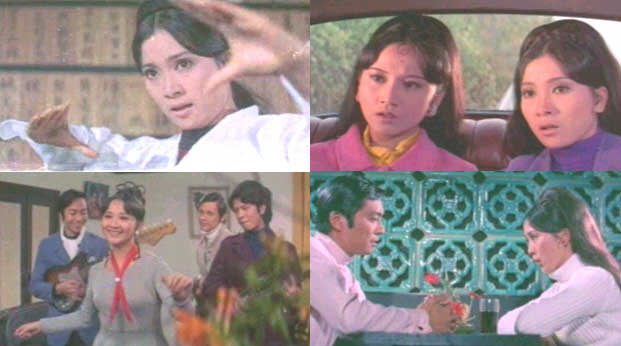
The film opens with Connie giving a judo demonstration to her class as she
takes on one student after another and tosses them around like paper dolls.
Having this skill will come in very handy over the next few days. She rooms
with her sister played by the very bubbly Nancy Sit and is being courted by
Kenneth Tsang – a plain clothes policeman and they like dressing the same
way when they go out. When not flipping people over her shoulder, she and
Nancy are singers at a nightclub where they pump out Technicolor tunes to
the obvious glee of what seem to be a bunch of horny old men who can barely
stay seated. In fact, we get three songs in a row – all filmed in that queasy
70’s soft-core soft focused colored glow in which faces appear in hearts or
in kaleidoscope images or all of a sudden the girls are surrounded by fields
of flowers. It’s so wonderfully tacky that you have to gurgle in pleasure
especially as the camera for some bizarre reason flashes back and forth between
ceramic figures for some effect that must have been cool at the time but is
totally mystifying now.
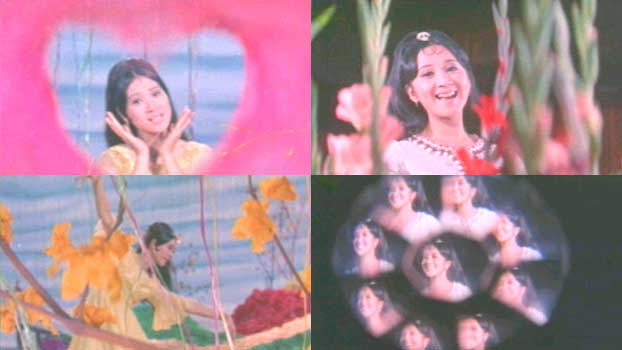
Without the subtitles there are some things I may have missed out on or
misinterpreted, but this is my best guess. After the lengthy musical interlude
the movie kicks into gear. A gang of five guys – headed by a young
Stanley Fung pre-moustache and including the bald-headed Fung King Man –
hold up a jewelry store – a few of them hidden behind stockings, the others
could only afford sunglasses I guess – and in their getaway one of them runs
into Nancy and she gets a good look at him. Along with Connie and Tsang she
is taken to police headquarters where Cheung Ching (who often starred in
Cathay films as the woeful boyfriend type) questions her. Back home they
receive a phone call and are threatened not to be witnesses, but instead
Nancy draws a picture of the man she bumped into. The next day while out
in the street they see this man coming at them – staggering – he has a knife
in his back and dies at their feet but not before a key comes slipping out
of his mouth and he tells them this will lead them to the stolen jewels.
The gang is right behind him and Connie gets into her first free for all
she as takes them all on in a good old fashioned punch em up.
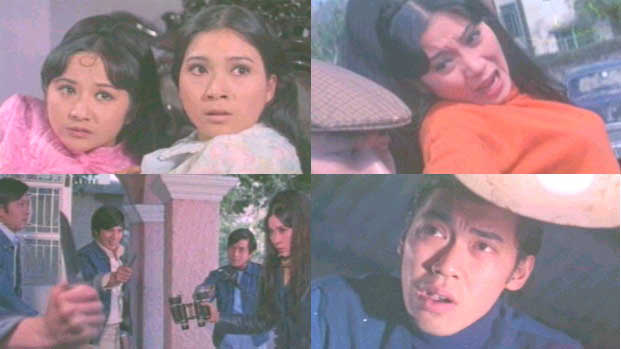
The film turns into a running scenario of the bad guys trying to track down
the two sisters because they have this key and Connie fighting them off –
with only some minor help from Nancy who apparently skipped her kung fu classes.
Two scenes make this film a minor classic. At one point Nancy is kidnapped
by the gang and Connie attempts to find her whereabouts. To do this she goes
into male mode – something she often did in her films apparently – as she
slicks back her hair, puts on jeans and sunglasses and has a cigarette dangling
from her mouth - maybe it’s just me but she never looked better and
wouldn’t fool a blind man at twenty paces. Her first stop of business is a
seedy shady pool hall where she takes a pool cue to some unruly heads to make
a point. This is witnessed by Fung who seemingly doesn’t recognize this “guy”
and invites “him” back to the gang’s hideout. If this was a Shaw film the
hideout would likely have been burrowed in a cliff with loads of fashion conscious
attendants running about – but the Cantonese films didn’t have that kind
of budget so their hideout has the look of a teenagers recroom with shag
rugs and a small phonograph to keep them entertained. They are having a party
and dancing something resembling the twist with a bevy of younger women and
Connie is playing it tough all the way as she takes a deep drag on her cigarette
like a dying man.
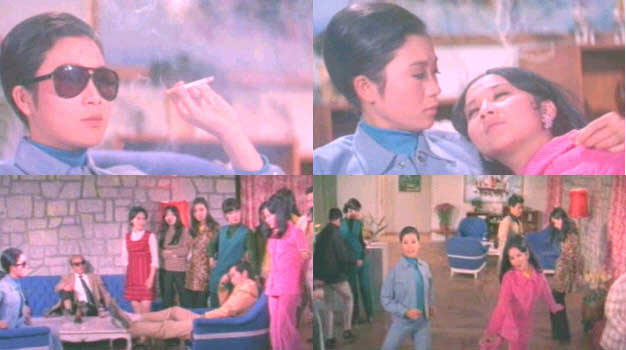
Stanley offers “her” one of these women to play with but after giving them
the up and down inspection she tells him they are not her type – she wants
something different to toy with. So they bring out a tied up Nancy who after
a few looks is able to penetrate the amazing disguise of her sister and coos
and happily sits on Connie’s lap and begins to purr. At this point Stanley
pulls out the little red pills and all his helpers and helpees grab one and
are soon in a near comatose state with them all hiccupping and twitching –
that is until he puts on a rock and roll song and soon they are all dancing
like Zombies from a “B” movie. Then things really get odd when the two sisters
give each other a knowing look and break into a song and dance number – that
should really throw the bad guys off their trail – but its so wonderfully
stupid that you can’t help but love it and replay it multiple times.
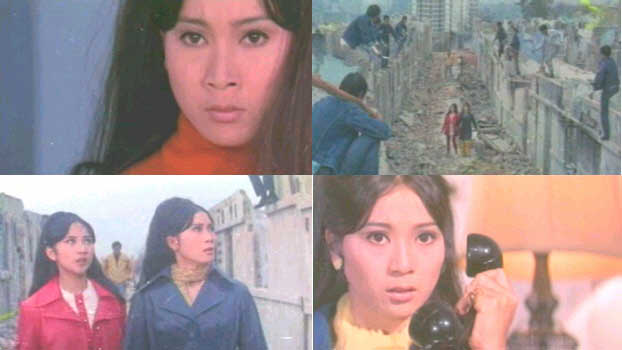
Later after having escaped yet one more time, the girls are once again being
tracked down by the gang and the final 20-minutes of the film turns into a
terrific set piece as the girls are chased all over and continuously fight
them off. Finally they find themselves trapped in a small neighborhood of
half-demolished buildings that act as backstops to all the action as the girls
dodge into one after another – by this time the original gang of five has
grown into the gang of thirty and there is a constant series of attacks -
all syncopated to a great jazz score that has infused the film from the beginning.
The choreography is very solid and Connie’s moves are very fluid and well
timed as she dodges kicks, punches and knife thrusts from a gaggle of bad
guys. This is just one of those films that you sit there and think - this
is so cool. By the way - I am just curious - the woman pictured below
performs a song in the nightclub and then disappears - does anyone know if
she was a singer at the time?
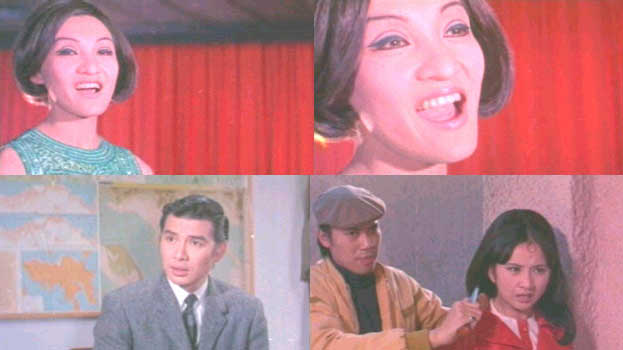
Both Connie and Nancy were members of the “The Seven Cantonese Princesses”
in the 1960’s – a term for a group of very popular young actresses in the
Cantonese film industry. The two biggest stars of them were Connie and Josephine
Siao with the others often in co-starring roles. Other than Nancy, the others
were child star Bo Bo Fung, Wong Oi-ming, Fung So-so (Bo Bo’s sister) and
Sum Chi-wah. These were the idols of their time. Connie was born in
1947 and both her parents were well-known Cantonese opera performers. As she
grew up she studied opera as well as certain styles of martial arts under
her parents – but because of her deep voice they thought she was suited to
playing male roles. At the age of ten she performed in her first opera and
soon moved into film in 1959 at the age of 12 making her debut in “The Scout
Master”. Later she mentored under the actress Yam Kim Fai and took easily
to acrobatic roles.
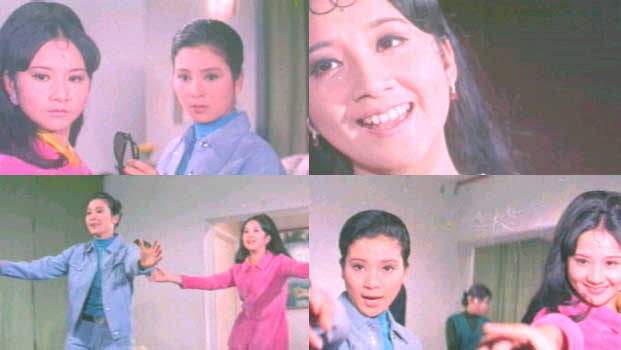
As she grew older she seamlessly moved into wuxia roles – often playing
a male figure – and over her career she made more than 90 wuxia films. She
had her hand in every genre though – romances in which she was paired with
Lui Kei for over 20 films, action, drama and musicals – basically she could
do it all and she became enormously popular. One of her first films to really
put her on the map was the 1965 “Black Rose” and in a short period of time
she made an amazing amount of films – often averaging around 20 a year. Basically
the popularity of her and Josephine kept Cantonese film alive till the end
of the decade. She first retired in 1970 and moved to Canada, but returned
for “The Lizard” but that was it. In 1999 she came back to perform on stage
taking on the character of her early teacher Yam Kim Fai.









